Modelling of Groundwater Potential Zones in Semi-Arid Areas Using Unmanned Aerial Vehicles, Geographic Information Systems, and Multi-Criteria Decision Making
Abstract
1. Introduction
2. Materials and Methods
2.1. Study Area
2.2. Workflow
2.3. UAV Technique
2.3.1. Equipment
2.3.2. Data Collection
2.3.3. UAV Processing
2.4. Generation of Thematic Layers by GIS
2.5. AHP Model
2.5.1. Assigning Ranks and Weights Using AHP
Saaty’s Scale
Standardisation of Thematic Layers
2.5.2. Weighting of Determining Factors
Pairwise Comparison
Normalised Weight
2.5.3. Assessing of Matrix Consistency
2.6. Deriving GWPZ
3. Results and Discussion
3.1. Thematic Maps
3.1.1. Elevation Model
3.1.2. Drainage Density
3.1.3. Lineament Density
3.1.4. Slope
3.1.5. Flood Zone
3.1.6. Topographic Wetness Index
3.1.7. Groundwater Potential Index
3.2. Model Validation
3.2.1. Validation with Borehole Yield Data
3.2.2. ROC-AUC
3.2.3. PCA Validation
4. Conclusions
Author Contributions
Funding
Data Availability Statement
Conflicts of Interest
References
- Wheater, H.S.; Gober, P. Water security and the science agenda. Water Resour. Res. 2015, 51, 5406–5424. [Google Scholar] [CrossRef]
- Thapa, R.; Gupta, S.; Guin, S.; Kaur, H. Assessment of groundwater potential zones using multi-influencing factor (MIF) and GIS: A case study from Birbhum district, west Bengal. Appl. Water Sci. 2017, 7, 4117–4131. [Google Scholar] [CrossRef]
- Das, N.; Sutapa, M. Application of multi-criteria making technique for the assessment of groundwater potential zones: A study on Birbhum district, West Bengal, India. Environ. Dev. Sustain. 2018, 22, 931–955. [Google Scholar] [CrossRef]
- Elshall, A.S.; Arik, A.D.; El-Kadi, A.I.; Pierce, S.; Ye, M.; Burnett, K.M.; Wada, C.A.; Bremer, L.L.; Chun, G. Groundwater sustainability: A review of the interactions between science and policy. Environ. Res. Lett. 2020, 15, 093004. [Google Scholar] [CrossRef]
- Abdo, H.G.; Vishwakarma, D.K.; Alsafadi, K.; Bindajam, A.A.; Malick, J.; Malick, S.K.; Kuma, K.C.A.; Kuriqi, J.A.A.; Artan Hysa, A. GIS-based multi-criteria decision making for delineation of potential groundwater recharge zones for sustainable resource management in the Eastern Mediterranean: A case study. Appl. Water Sci. 2024, 14, 160. [Google Scholar] [CrossRef]
- El-Sayed, H.M.; Elgendy, A.R. Geospatial and geophysical insights for groundwater potential zones mapping and aquifer evaluation at Wadi Abu Marzouk in El-Nagila, Egypt. Egypt. J. Aquat. Res. 2024, 50, 23–35. [Google Scholar] [CrossRef]
- World Health Organization (WHO). Report on Surveillance of Antibiotic Consumption: 2016–2018 Early Implementation; World Health Organization: Geneva, Switzerland, 2018. [Google Scholar]
- UN (United Nation). Report on Sustainable Development Objectives; United Nation: New York, NY, USA, 2019. [Google Scholar]
- World Health Organization (WHO). A Global Overview of National Regulations and Standards for Drinking-Water Quality, 2nd ed.; World Health Organization: Geneva, Switzerland, 2021; ISBN 978-92-4-002364-2. [Google Scholar]
- Anusha, B.N.; Babu, K.R.; Kumar, B.P.; Kumar, P.R.M.; Rajasekhar, M. Geospatial approaches for monitoring and mapping of water resources in semi-arid regions of southern India. Environ. Chall. 2022, 8, 100569. [Google Scholar] [CrossRef]
- Das, S.C.; Akhtar, F.; Alrasheedi, A.F.; Akbar, A.C. Application of water cycle algorithm with demand follows green level and nonlinear power pattern of the product for an inventory system. Sci. Rep. 2024, 14, 20995. [Google Scholar] [CrossRef] [PubMed]
- Franke, J. Drying groundwater. Nat. Clim. Chang. 2024, 14, 896. [Google Scholar] [CrossRef]
- Rohde, M.M.; Albano, C.M.; Huggins, X.; Kirk, R.; Klausmeyer, K.R.; Charles Morton, C.; Sharman, A.; Zaveri, E.; Laurel Saito, L.; Freed, Z.; et al. Groundwater-dependent ecosystem map exposes global dryland protection needs. Nature 2024, 632, 101–107. [Google Scholar] [CrossRef]
- Turner, S.W.D.; Rice, J.S.; Nelson, K.D.; Vernon, C.R.; McManamay, R.; Dickson, K.; Marston, L. Comparison of potential drinking water source contamination across one hundred U.S. cities. Nat. Commun. 2021, 12, 7254. [Google Scholar] [CrossRef] [PubMed]
- Hashimoto, R.; Kazama, S.; Hashimoto, T.; Oguma, K.; Takizawa, S. Planning methods for conjunctive use of urban water resources based on quantitative water demand estimation models and groundwater regulation index in Yangon City, Myanmar. J. Clean. Prod. 2022, 367, 133123. [Google Scholar] [CrossRef]
- Minuyelet, Z.M.; Kasie, L.A.; Bogale, S. Groundwater potential zones delineation using GIS and AHP techniques in upper parts of Chemoga watershed, Ethiopia. Appl. Water Sci. 2024, 14, 85. [Google Scholar]
- Mir, M.R.; McDermid, G.J.; Strack, M.; Lovitt, J. A New Method to Map Groundwater Table in Peatlands Using Unmanned Aerial Vehicles. Remote Sens. 2017, 9, 1057. [Google Scholar] [CrossRef]
- Chen, W.; Tsangaratos, P.; Ilia, I.; Duan, Z.; Chen, X. Groundwater spring potential mapping using population-based evolutionary algorithms and data mining methods. Sci. Total Environ. 2019, 684, 31–49. [Google Scholar] [CrossRef] [PubMed]
- Smith, C.; Satme, J.; Martin, J.; Downey, A.R.J.; Vitzilaios, N.; Imran, J. UAV rapidly-deployable stage sensor with electro-permanent magnet docking mechanism for flood monitoring in undersampled watersheds. HardwareX 2022, 12, e00325. [Google Scholar] [CrossRef]
- Bhuyan, M.J.; Deka, N. Delineation of groundwater potential zones at micro-spatial units of Nagaon district in Assam, India, using GIS-based MCDA and AHP techniques. Environ. Sci. Pollut. Res. 2022, 3, 54107–54128. [Google Scholar] [CrossRef]
- Orojah, J.O.; Eshimiakhe, D.; Oniku, A.S.; Kolawole, M.L. Application of remote sensing and electrical resistivity technique for delineating groundwater potential in North Western Nigeria. Sci. Rep. 2024, 14, 22299. [Google Scholar]
- EL-Bana, E.M.M.; Alogayell, H.M.; Sheta, H.M.; Abdelfattah, M. An integrated remote sensing and GIS-based technique for mapping groundwater recharge zone: A case study of SW Riyadh, Central Saudi Arabia. Hydrology 2024, 11, 38. [Google Scholar] [CrossRef]
- Acharya, B.S.; Bhandari, M.; Bandini, F.; Pizarro, A.; Perks, M.; Joshi, R.D.; Wang, S.; Dogwiler, T.; Rai, R.L.; Kharel, G.; et al. Unmanned aerial vehicles in hydrology and water management applications, challenges, and perspectives. Water Resour. Res. 2021, 57, 1944–7973. [Google Scholar] [CrossRef]
- Vellemu, E.C.; Katonda, I.; Abiou, V.; Yapuwa, H.; Msuku, G.; Nkhoma, S.; Makwakwa, C.; Safuya, K.; Maluwa, A. Using the Mavic 2 Pro drone for basic water assessment. Sci. Afr. 2021, 14, e00979. [Google Scholar] [CrossRef]
- Vélez, N.M.; García, L.S.; Barbero, L.; Verónica Ruiz, O.; Sánchez, B.A. Applications of Unmanned Aerial Systems (UASs) in Hydrology: A Review. Remote Sens. 2021, 13, 1359. [Google Scholar] [CrossRef]
- Lee, E.; Park, S.; Jang, H.; Choi, W.; Sohn, H.G. Enhancement of low-cost UAV-based photogrammetric point cloud using MMS point cloud and oblique images for 3D urban reconstruction. Measurement 2024, 226, 114158. [Google Scholar] [CrossRef]
- Liu, Z.; Li, J.; Shen, J.; Wang, X.; Chen, P. Leader–follower UAVs formation control based on a deep Q-network collaborative framework. Sci. Rep. 2024, 14, 4674. [Google Scholar] [CrossRef]
- Román, A.; Navarro, G.; Tovar, A.S.; Zarandona, P.; Roque, D.A.; Barbero, L. Shetlands UAV metry: Unmanned aerial vehicle-based photogrammetric dataset for Antarctic environmental research. Sci. Data 2024, 11, 202. [Google Scholar] [CrossRef] [PubMed]
- Rui, Y.; Wang, C.; Barton, N.; Du, S. A photogrammetric approach for quantifying the evolution of rock joint void geometry under varying contact states. Int. J. Min. Sci. Technol. 2024, 34, 461–477. [Google Scholar]
- Kouamou Njifen, S.R.; Enyegue ANyam, F.M.; Bikoro, M.B.A.; Ngouokouo, A.T.; Tabod, C.T. Modeling groundwater potential zones in the Kribi-Campo region, South Cameroon using geospatial techniques and statistical models. Model. Earth Syst. Environ. 2022, 9, 913–935. [Google Scholar] [CrossRef]
- Vellaikannu, A.; Palaniraj, U.; Karthikeyan, S.; Senapathi, V.; Viswanathan, P.M.; Sekar, S. Identification of groundwater potential zones using geospatial approach in Sivagangai district, South India. Arab. J. Geosci. 2021, 14, 8. [Google Scholar] [CrossRef]
- Shebl, A.; Abdelaziz, M.I.; Ghazala, H.; Awad, S.S.A.; Abdellatif, M.; Csámer, A. Multi-criteria ground water potentiality mapping utilizing remote sensing and geophysical data: A case study within Sinai Peninsula. Egypt. J. Remote Sens. Space Sci. 2022, 25, 765–778. [Google Scholar] [CrossRef]
- Ikrri, M.; Boutaleb, I.; Abiou, M.; Zahra, F.E.; Abdelrahman, K.; Mouna, I.; Tamer, A.; Hasna, E.A.; Sara, E.; Farid, F. Delineation of groundwater potential area using an AHP, remote sensing, and GIS Techniques in the Ifni Basin, Western Anti-Atlas, and Morocco. Water 2023, 15, 1436. [Google Scholar] [CrossRef]
- Akatsuka, T.; Saito, R.; Kajiwara, T.; Osada, K.; Nagaso, M.; Norihiro, W.N.; Tsuchiya, N.; Hiroshi, A.; Kanetsuki, T. Geothermal geology and comprehensive temperature model based on surface and borehole geology in Sengan, Northeast Japan. Geothermics 2022, 105, 102485. [Google Scholar] [CrossRef]
- Yeh, H.C.; Chen, Y.C.; Wei, C. A new approach to select a regionalized design hyetograph by principal component analysis and analytic hierarchy process. Paddy Water Environ. 2011, 11, 73–83. [Google Scholar] [CrossRef]
- Kamijo, T.; Chen, Y.C.; Wei, C. A verification of alternative assessment using principal component analysis based on case studies of the japan international cooperation agency. Paddy Water Environ. 2014, 45, 31–38. [Google Scholar]
- Kong, G.; Jiang, L.; Yin, X.; Wang, T.; Xu, D.L.; Yang, J.B.; Hu, Y. Combining principal component analysis and the evidential reasoning approach for healthcare quality assessment. Ann. Oper. Res. 2018, 271, 679–699. [Google Scholar] [CrossRef]
- Diana, G.; Tommasi, C. Cross-validation methods in principal component analysis: A comparison. Stat. Methods Appl. 2002, 11, 71–82. [Google Scholar] [CrossRef]
- Koffi, Y.P.; Aretouyap, Z.; Gweth, M.M.A.; Meli’i, J.L.; Biringanine, G.N.; Fils, S.C.N.; Oyoa, V.; Marcel, J.; Perilli, N.; Nouck, P.N. Contribution of Landsat imagery to map vulnerable areas to seawater intrusion along the Mt.-Cameroon coastal area using lineaments pattern. J. Afr. Earth Sci. 2023, 204, 104937. [Google Scholar] [CrossRef]
- Fomekong, L.C.; Fomekong, L.C.; Meli’i, J.L.; Ekoro, N.H.; Njeudjang, K.; Pouth, N.A.M.; Njandjock, N.P. Identifying water-lubricated faults in the vicinity of a dam. Egypt. J. Remote Sens. Space Sci. 2025, 28, 99–115. [Google Scholar]
- Tchato, C.S.; Gounou, P.B.P.; Gweth, M.M.A.; Kayo, P.E.F.; Pouth, N.A.M.; Mbouombouo, N.I.; Poufone, K.Y.; Manguelle-Dicoum, E.; Njandjock, N.P. Possible Influence of Brittle Tectonics on the Main Road Network Built in the Central African Environment Using Remote Sensing and GIS. Sustainability 2023, 15, 15551. [Google Scholar] [CrossRef]
- Ngnotué, T.; Nzenti, J.P.; Sing, A.; Barbey, P.; Tchoua, F.M. The Ntui-Betamba high-grade gneiss: A northward extension of the pan-afriacn Yaoundé gneiss in Cameroon. J. Afr. Earth Sci. 2000, 31, 369–381. [Google Scholar] [CrossRef]
- Beni, T.; Borselli, D.; Bonechi, L.; Lombardi, L.; Gonzi, S.; Melelli, M.; Turchetti, M.A.; Fanò, L.; Alessandro, R.; Gigli, G.; et al. Laser scanner and UAV digital photogrammetry as support tools for cosmic-ray muon radiography applications: An archaeological case study from Italy. Sci. Rep. 2023, 13, 19983. [Google Scholar] [CrossRef]
- Yeh, H.F.; Cheng, Y.S.; Lin, H.I.; Lee, C.H. Mapping groundwater recharge potential zone using a GIS approach in Hualian River. Taiwan. Sustain. Environ. Res. 2016, 26, 33–43. [Google Scholar] [CrossRef]
- Garcia, L.S.; Velez, N.M.; Martinez, L.J.; Bellon, S.A.; Pacheko, O.M.J.; Ruiz, O.V.; Munoz, J.J.P.; Barbero, L. Using UAV photogrammetry and automated sensors to assess aquifer recharge from a coastal wetland. Remote Sens. 2022, 14, 6185. [Google Scholar] [CrossRef]
- Arulbalaji, P.; Padmalal, D.; Sreelash, K. GIS and AHP Techniques Based Delineation of Groundwater Potential Zones: A case study from Southern Western Ghats, India. Sci. Rep. 2019, 9, 2082. [Google Scholar] [CrossRef]
- Abdullahi, A.; Muralitharan, J.; Getahun, E.; Gunalan, J.; Abebe, A. Assessment of potential groundwater Zones in the drought-prone Harawa catchment, Somali region, eastern Ethiopia using geospatial and AHP techniques. Egypt. J. Remote Sens. Space Sci. 2023, 26, 628–641. [Google Scholar] [CrossRef]
- El Mekki, A.O.; Laftouhi, N.E. Combination of a geographical information system and remote sensing data to map groundwater recharge potential in arid to semi-arid areas: The Haouz Plain, Morocco. Earth Sci. Inform. 2016, 9, 465–479. [Google Scholar] [CrossRef]
- Nshagali, B.G.; Meli’i, J.L.; Nyouma, R.N.; Marcel, J.; Oyoa, V.; Perilli, N.; Nouck, P.N. Groundwater Potential index map and characterization of unconfined aquifers, in crystalline basement region of Cameroon, using Multicriteria Decision Making. Arab. J. Geosci. 2022, 15, 1594. [Google Scholar]
- Saaty, T.L. How to make a decision: The analytic hierarchy process. Eur. J. Oper. Res. 1990, 48, 9–26. [Google Scholar] [CrossRef]
- Patel, A.K.; Sharma, M.; Sing, A.; Dubey, S.; Chandola, V.K.; Mishra, S. Groundwater potential zones using multi-criteria decision making for Mirzapur, District, U.P., India. Int. J. Environ. Clim. Chang. 2024, 14, 27–45. [Google Scholar] [CrossRef]
- Saaty, T.L. Fundamentals of the analytic network process—Multiple networks with benefits, costs, opportunities and risks. J. Syst. Sci. Syst. Eng. 2004, 13, 348–379. [Google Scholar] [CrossRef]
- Pouth, N.A.M.; Meli’i, J.L.; Gweth, M.M.; Gounou, P.B.P.; Njock, M.C.; Teikeu, A.W.; Mbouombouo, N.I.; Poufone, Y.K.; Wouako, W.R.K.; Njandjock, N.P. An approach to assess hazards in the vicinity of mountain and volcanic areas. Landslides 2024, 22, 693–708. [Google Scholar] [CrossRef]
- Gweth, M.M.A.; Nkoungou, H.E.; Meli’i, J.L.; Gouet, D.H.; Njandjock, N.P. Fractures models comparison using GIS data around crater lakes in Cameroon volcanic line environment. Egypt. J. Remote Sens. Space Sci. 2021, 24, 419–429. [Google Scholar]
- Gweth, M.M.A.; Jorelle Larissa Meli’i, J.L.; Oyoa, V.; Diab, D.A.; Gouet, D.H.; Marcel, J.; Njandjock, N.P. Fracture network mapping using remote sensing in three crater lakes environments of the Cameroon volcanic line (central Africa). Arab. J. Geosci. 2021, 14, 422. [Google Scholar] [CrossRef]
- Poufone, K.P.; Meli’i, J.L.; Aretouyap, Z.; Gweth, M.M.A.; Nguemhe, S.C.F.; Nshagali, G.B.; Oyoa, V.; Perilli, N.; Njandjock, N.P. Possible pathways of seawater intrusion along the MountCameroon coastal area using remote sensing and GIS techniques. Adv. Space Res. 2022, 69, 2047–2060. [Google Scholar] [CrossRef]
- Andualem, T.G.; Demeke, G.G. Groundwater potential assessment using GIS and remote sensing: A case study of Guna tana landscape, upper Blue Nile Basin, Ethiopia. J. Hydrol. Reg. Stud. 2019, 24, 100610. [Google Scholar] [CrossRef]
- Tolche, A.D. Groundwater potential mapping using geospatial techniques: A case study of Dhungeta-Ramis sub-basin, Ethiopia. Geol. Ecol. Landsc. 2020, 5, 65–80. [Google Scholar] [CrossRef]
- Githinji, T.W.; Dindi, E.W.; Kuria, Z.N.; Olago, D.O. Application of analytical hierarchy process and integrated fuzzy-analytical hierarchy process for mapping potential groundwater recharge zone using GIS in the arid areas of Ewaso Ng’iro–Lagh Dera Basin, Kenya. HydroResearch 2022, 5, 22–34. [Google Scholar] [CrossRef]
- Sulaiman, W.H.; Mustafa, Y.T. Geospatial multi-criteria evaluation using AHP- GIS to delineate groundwater potential zones in Zakho Basin, Kurdistan Region, Irak. Earth 2023, 4, 655–675. [Google Scholar] [CrossRef]
- Saha, S. Groundwater potential mapping using analytical hierarchical process: A study on Md. Bazar Block of Birbhum District, West Bengal. Spat. Inf. Res. 2017, 25, 615–626. [Google Scholar] [CrossRef]
- Mallick, J.; Khan, R.A.; Ahmed, M.; Alqadhi, S.D.; Alsubih, M.; Falqi, I.; HASSAN, M.A. Modeling groundwater potential zone in a semi-arid region of Aseer using Fuzzy-AHP and geoinformation techniques. Water 2019, 11, 2656. [Google Scholar] [CrossRef]

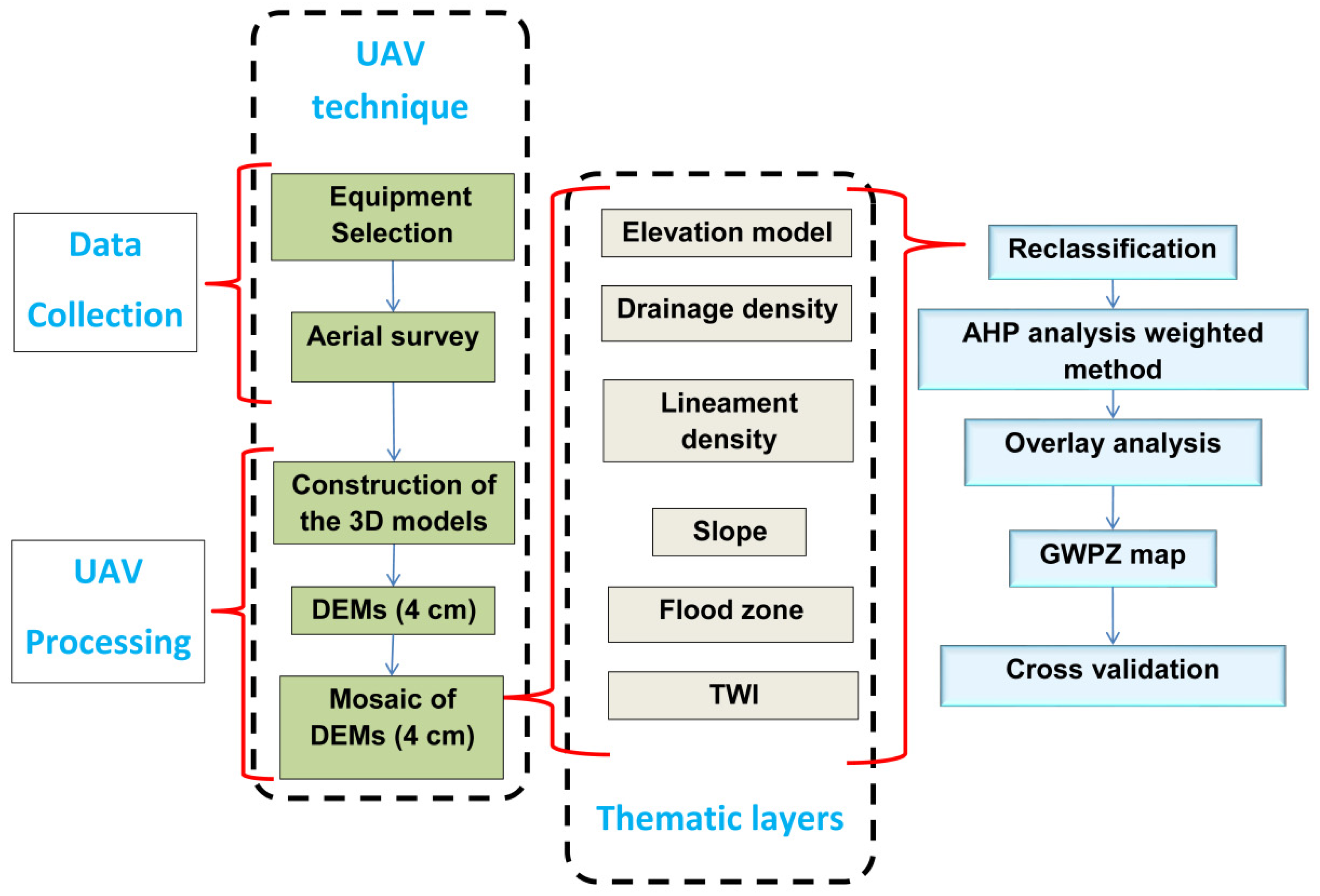
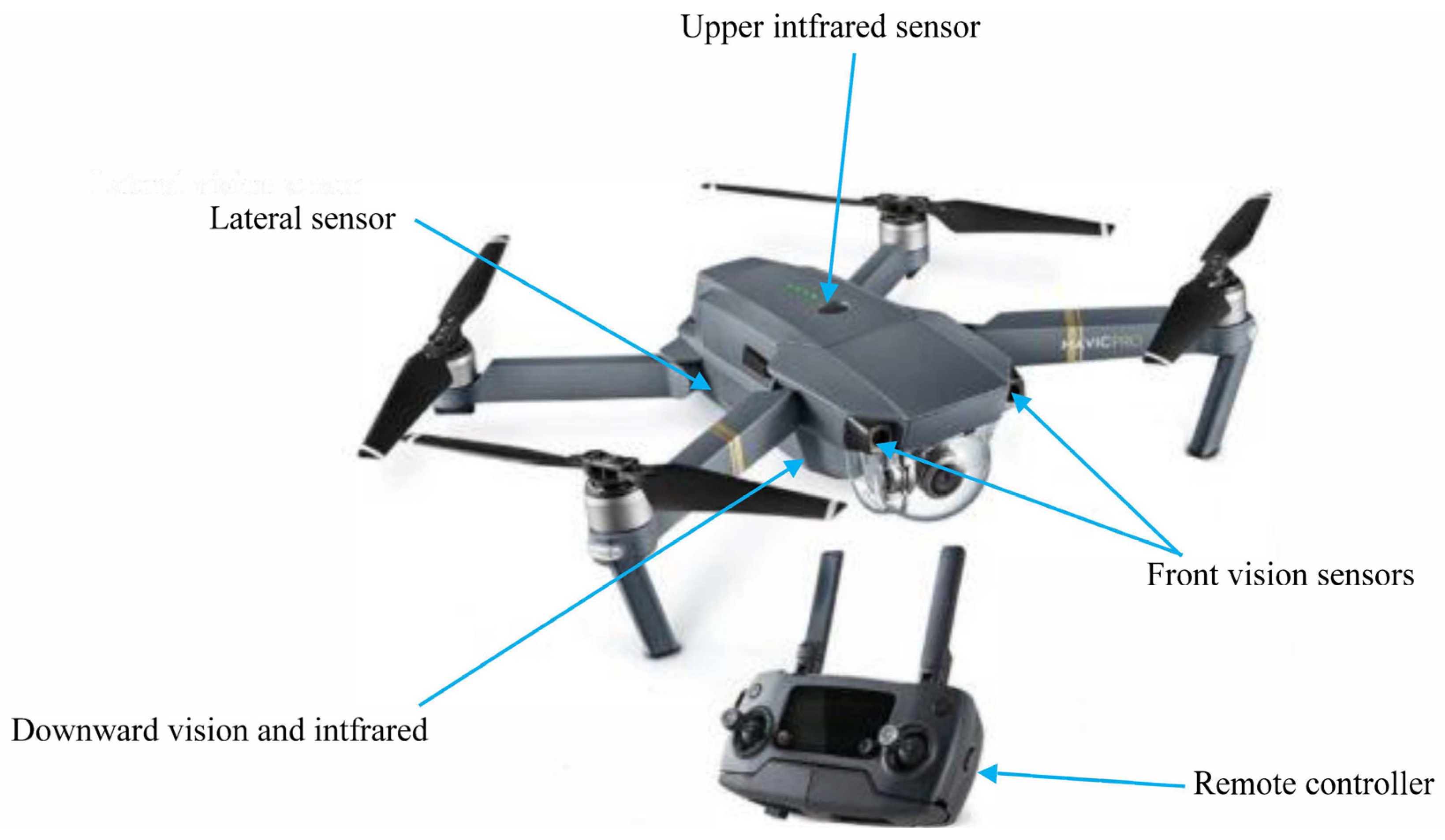
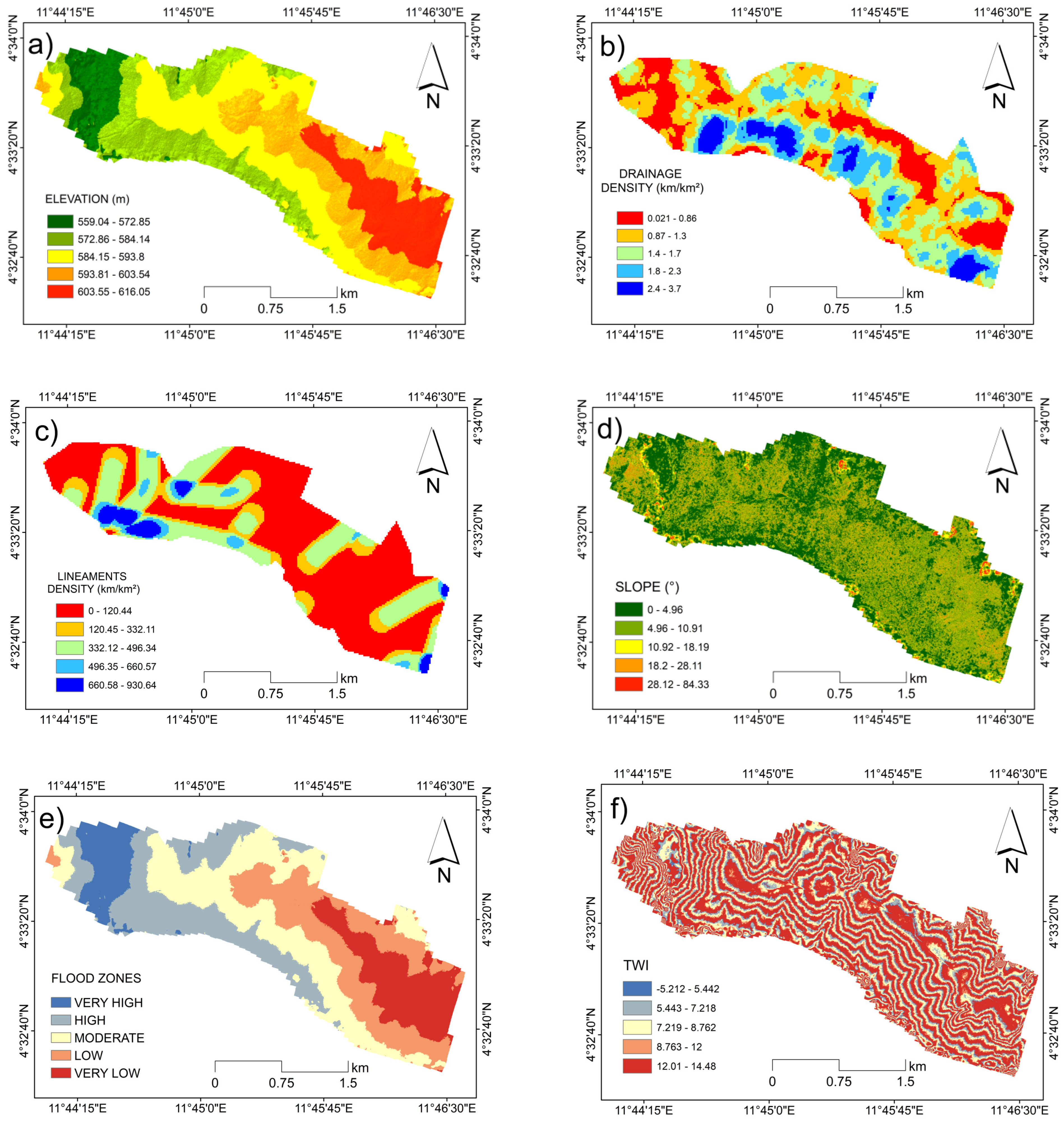
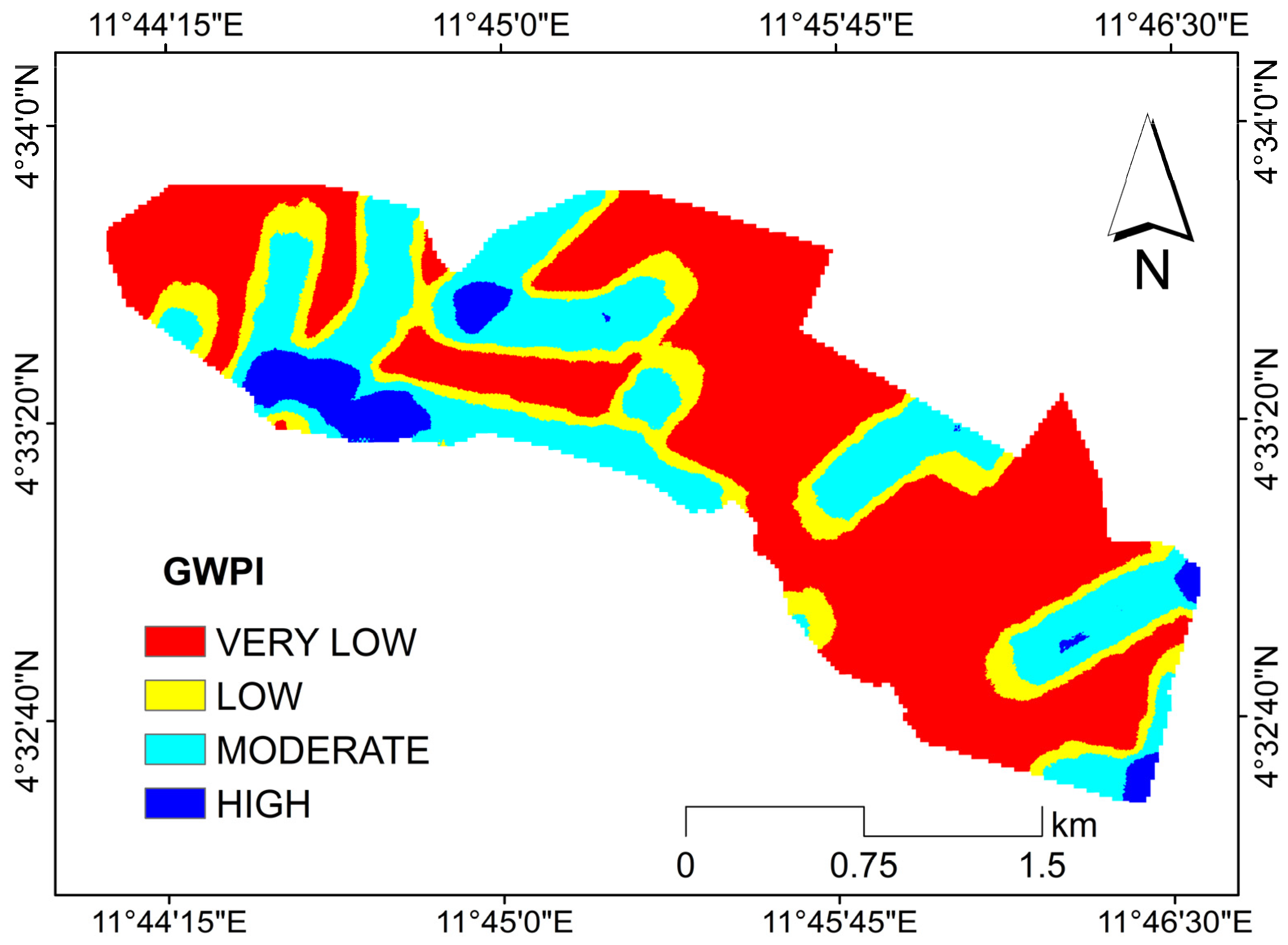
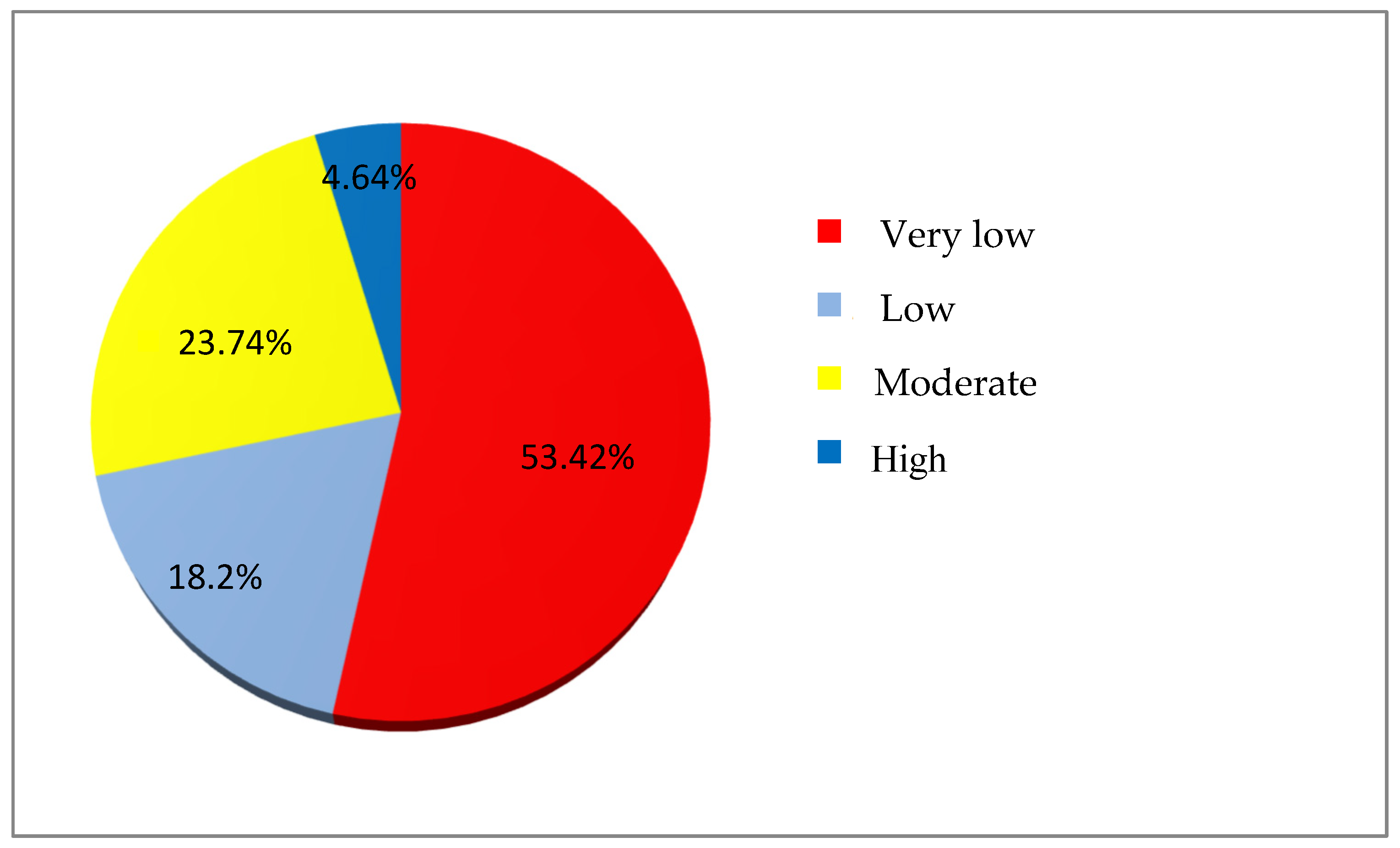
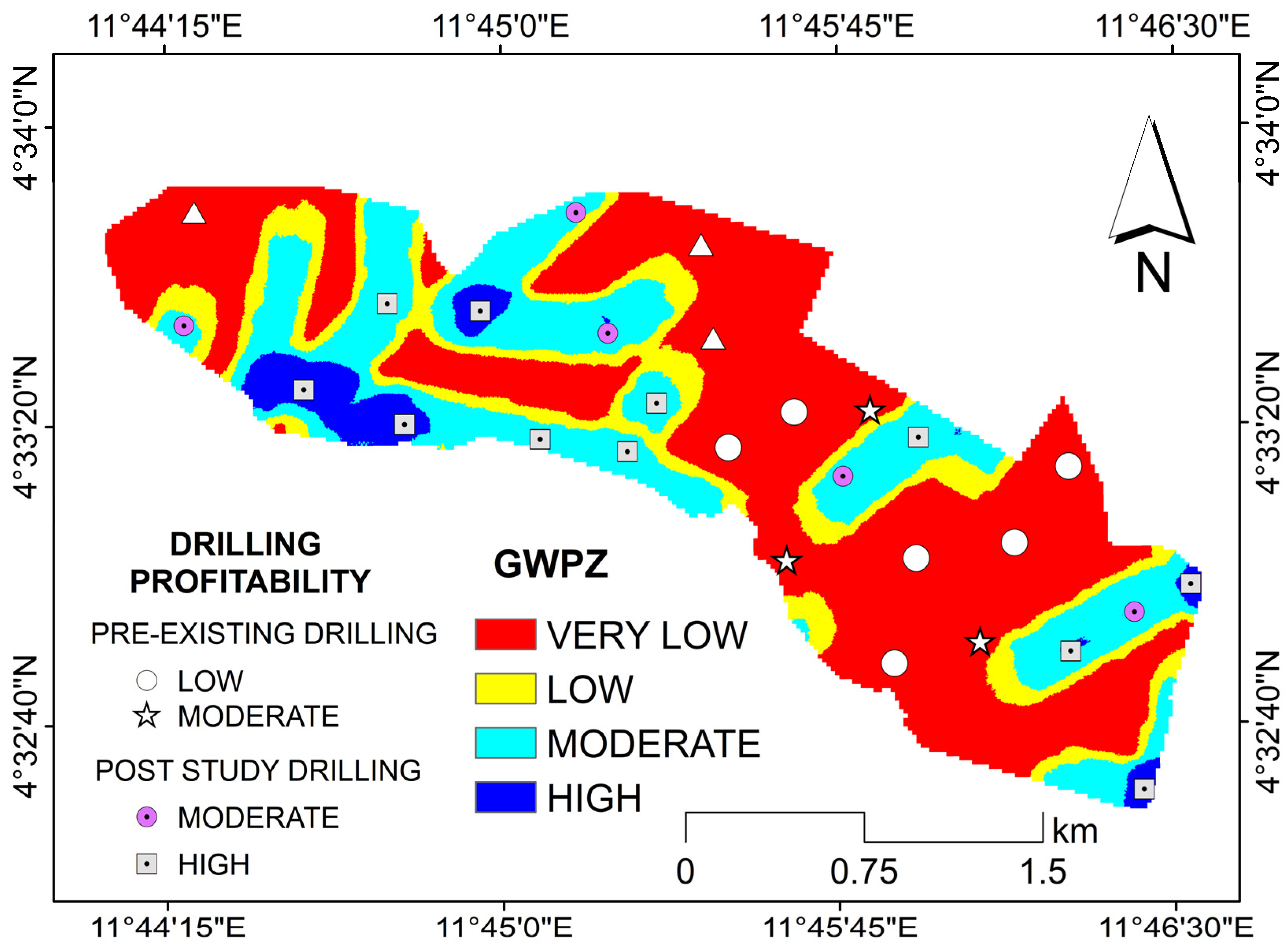
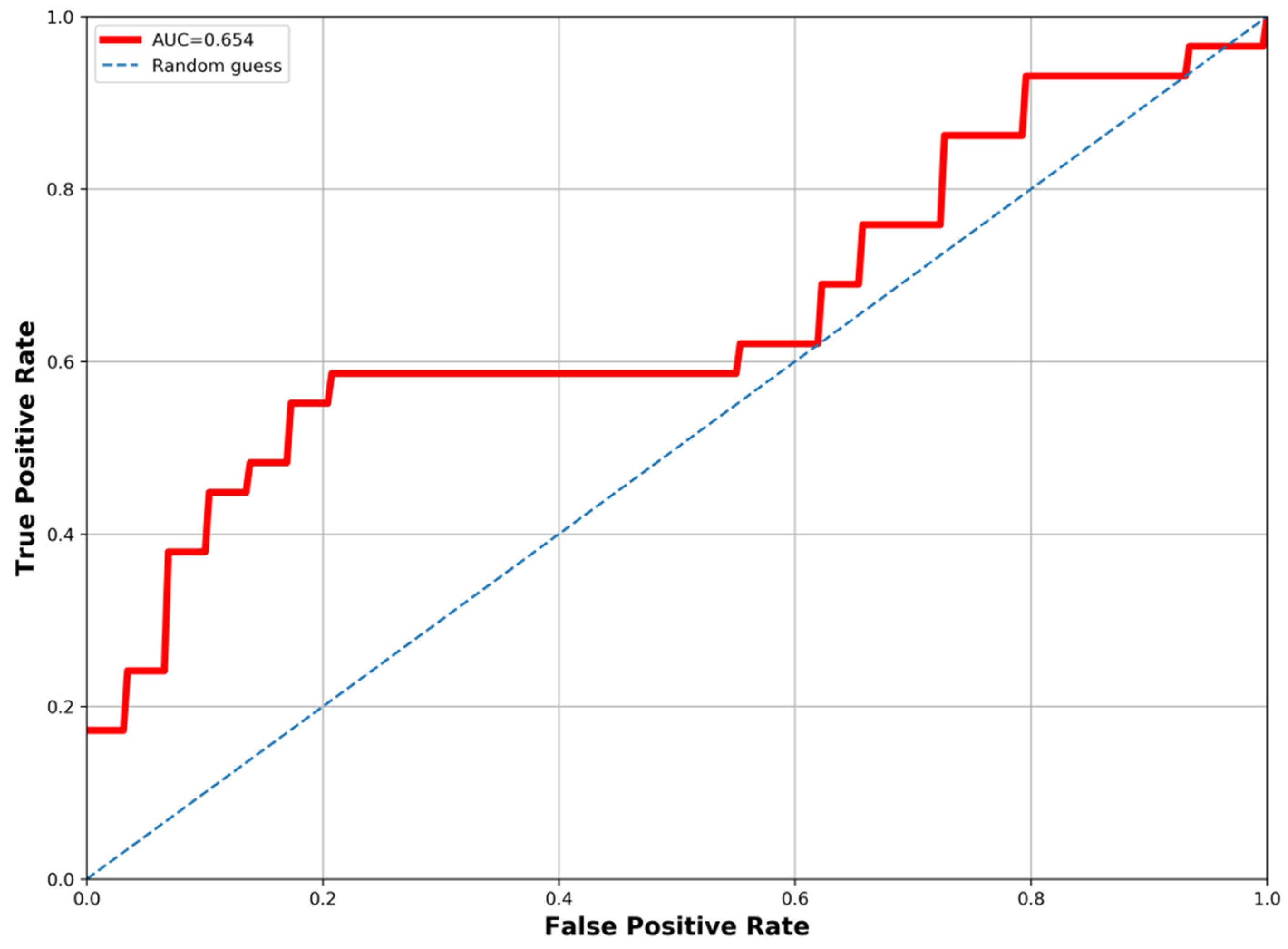
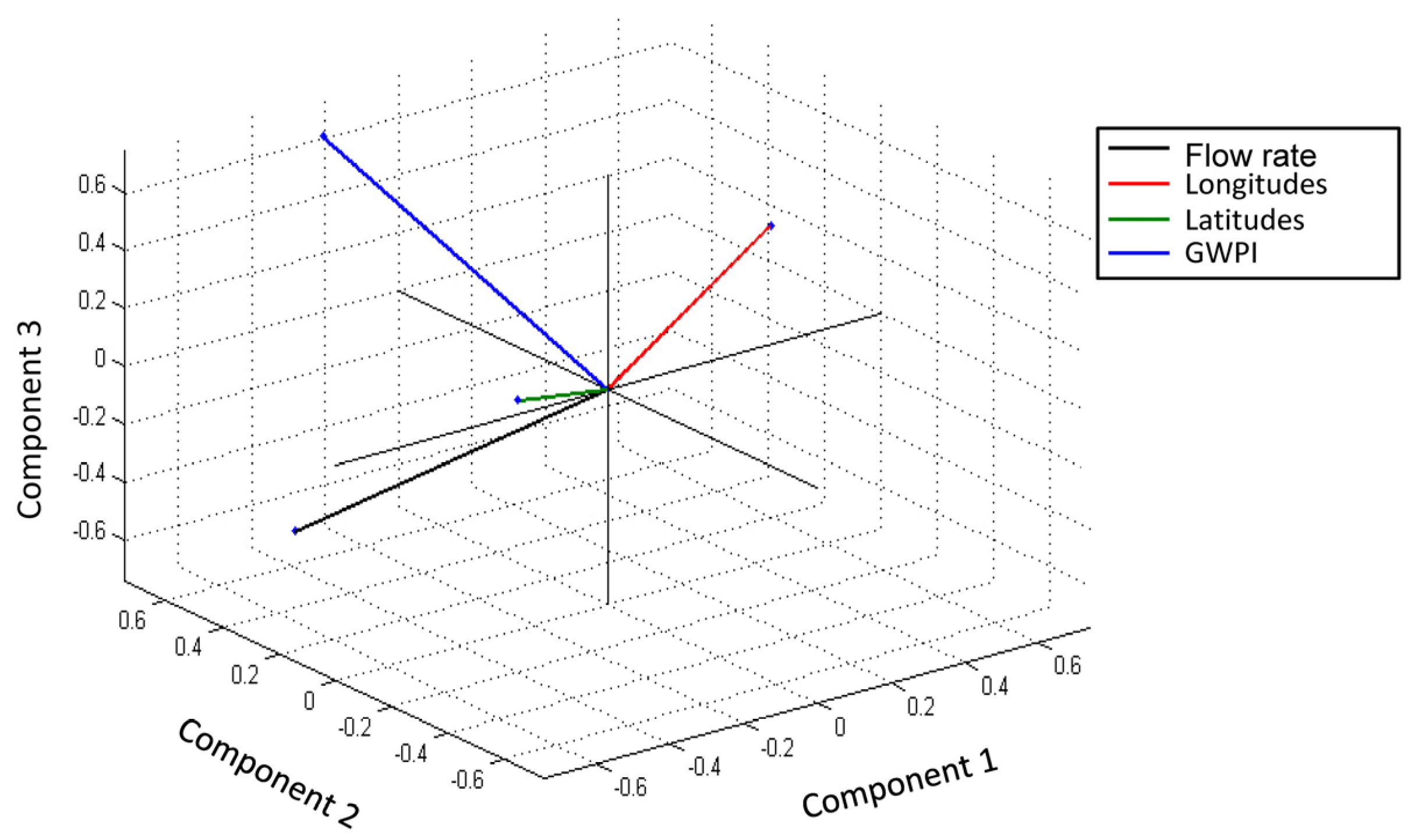
| Intensity of Importance | Definition |
|---|---|
| 1 | Equal Importance |
| 2 | Equal to moderate importance |
| 3 | Moderate importance |
| 4 | Moderate to strong importance |
| 5 | Strong importance |
| 6 | Strong to very strong importance |
| 7 | Very strong importance |
| 8 | Very to extremely strong importance |
| 9 | Extreme importance |
| Factors | Classes | Potentiality | Criterion Weight | Rank | Normalised Weight | |
|---|---|---|---|---|---|---|
| EM | 556.8–572.99 | Very good | 0.51 | 5.00 | 0.36 | |
| 573–584.33 | Good | 0.24 | 4.00 | |||
| 584.34–594.04 | Medium | 0.13 | 2.00 | |||
| 594.05–603.76 | Poor | 0.07 | 1.00 | |||
| 603.77–625.62 | Very poor | 0.05 | 1.00 | |||
| DD | 0.021–0.86 | Very good | 0.44 | 5.00 | 0.25 | |
| 0.87–1.3 | Good | 0.26 | 4.00 | |||
| 1.40–1.70 | Medium | 0.17 | 1.00 | |||
| 1.80–2.30 | Poor | 0.09 | 1.00 | |||
| 2.40–3.70 | Very Poor | 0.04 | 1.00 | |||
| LD | 0–120.44 | Very poor | 0.41 | 5.00 | 0.1630295 | |
| 120.45–332.11 | Poor | 0.26 | 3.00 | |||
| 332.12–496.34 | Moderate | 0.19 | 2.00 | |||
| 496.35–660.57 | Good | 0.09 | 1.00 | |||
| 660.58–930.64 | Very good | 0.05 | 1.00 | |||
| SL | 0–4.96 | Very good | 0.40 | 5.00 | 0.10438802 | |
| 4.96–10.91 | Good | 0.22 | 4.00 | |||
| 10.92–18.19 | Moderate | 0.19 | 3.00 | |||
| 18.2–28.11 | Poor | 0.17 | 2.00 | |||
| 28.12–84.33 | Very poor | 0.02 | 1.00 | |||
| FZ | 557.17–573 | Very good | 0.34 | 5.00 | 0.06671751 | |
| 573.01–584.26 | Good | 0.23 | 4.00 | |||
| 584.27–594.19 | Moderate | 0.16 | 3.00 | |||
| 594.2–603.85 | Poor | 0.15 | 2.00 | |||
| 603.86–625.58 | Very poor | 0.12 | 1.00 | |||
| TWI | 5.212–5.442 | Very poor | 0.5 | 5.00 | 0.0493883 | |
| 5.443–7.218 | Poor | 0.3 | 4.00 | |||
| 7.219–8.762 | Moderate | 0.12 | 3.00 | |||
| 8.763–12 | Good | 0.05 | 2.00 | |||
| 12.01–14.48 | Very good | 0.03 | 1.00 | |||
| EM | DD | LD | SL | FZ | TWI | |
|---|---|---|---|---|---|---|
| EM | 1 | 2 | 3 | 4 | 5 | 4 |
| DD | 0.5 | 1 | 2 | 3 | 4 | 5 |
| LD | 0.333 | 0.5 | 1 | 2 | 3 | 4 |
| SL | 0.25 | 0.333 | 0.5 | 1 | 2 | 3 |
| FZ | 0.2 | 0.25 | 0.333 | 0.5 | 1 | 2 |
| TWI | 0.25 | 0.2 | 0.25 | 0.333 | 0.5 | 1 |
| EM | DD | LD | SL | FZ | TWI | Criteria Weight | |
|---|---|---|---|---|---|---|---|
| EM | 0.39473684 | 0.46692607 | 0.42352941 | 0.36923077 | 0.32258065 | 0.21052632 | 0.028 |
| DD | 0.19736842 | 0.23346304 | 0.28235294 | 0.27692308 | 0.25806452 | 0.26315789 | 0.014 |
| LD | 0.13157895 | 0.11673152 | 0.14117647 | 0.18461538 | 0.19354839 | 0.21052632 | 0.021 |
| SL | 0.09868421 | 0.07782101 | 0.07058824 | 0.09230769 | 0.12903226 | 0.15789474 | 0.030 |
| FZ | 0.07894737 | 0.05836576 | 0.04705882 | 0.04615385 | 0.06451613 | 0.10526316 | 0.026 |
| TWI | 0.09868421 | 0.04669261 | 0.03529412 | 0.03076923 | 0.03225806 | 0.05263158 | 0.016 |
| n | 2 | 3 | 4 | 5 | 6 | 7 | 8 | 9 | 10 | 11 | 12 | 13 | 14 |
| RI | 0 | 0.52 | 0.9 | 1.12 | 1.24 | 1.32 | 1.41 | 1.45 | 1.49 | 1.51 | 1.53 | 1.56 | 1.57 |
| Level | Area (km2) | Proportions (%) |
|---|---|---|
| Very low | 2.671 | 53.42 |
| Low | 0.91 | 18.2 |
| Moderate | 1.187 | 23.74 |
| High | 0.232 | 4.64 |
| Total | 5.00 | 100 |
| Number of Boreholes | Latitude | Longitude | Flow Rate (L/s) | Actual Yield Rank | Expected Yield Predicted from GWPI | Agreement Between Actual and Predicted |
|---|---|---|---|---|---|---|
| 1 | 807.812447 | 502.623977 | 14.2 | very good | high | Agree |
| 2 | 807.508868 | 503.190658 | 13.1 | very good | moderate | Disagree |
| 3 | 807.77197 | 503.352567 | 10.3 | good | moderate | Agree |
| 4 | 807.498749 | 503.949606 | 2.6 | very low | very low | Agree |
| 5 | 807.276124 | 503.635908 | 2.4 | very low | very low | Agree |
| 6 | 807.134454 | 503.231136 | 7.6 | medium | very low | Disagree |
| 7 | 806.780278 | 503.140062 | 2.9 | very low | very low | Agree |
| 8 | 806.679085 | 504.18235 | 9.5 | medium | very low | Disagree |
| 9 | 806.567773 | 503.909129 | 10 | medium | moderate | Agree |
| 10 | 806.335029 | 503.565073 | 8.7 | medium | very low | Disagree |
| 11 | 806.365386 | 504.172231 | 2.8 | very low | very low | Agree |
| 12 | 805.980853 | 504.860344 | 4.9 | low | very low | Agree |
| 13 | 806.031449 | 504.47581 | 4.6 | low | very low | Agree |
| 14 | 805.677274 | 504.010322 | 11.8 | good | moderate | Agree |
| 15 | 805.596319 | 504.496049 | 8.6 | medium | moderate | Agree |
| 16 | 805.464768 | 504.991895 | 10.8 | medium | moderate | Agree |
| 17 | 805.070116 | 504.587122 | 13.4 | good | high | Disagree |
| 18 | 804.756417 | 504.121634 | 14.2 | very good | high | Agree |
| 19 | 804.341526 | 504.263305 | 14.8 | very good | high | Agree |
| 20 | 804.685582 | 504.61748 | 12.3 | good | moderate | Agree |
| 21 | 803.84568 | 504.526407 | 8.7 | medium | moderate | Agree |
| 22 | 803.886157 | 504.991895 | 3.7 | low | very low | Agree |
| 23 | 808.004422 | 503.467351 | 15 | very good | high | Agree |
| 24 | 806.879098 | 504.069268 | 12.7 | good | moderate | Agree |
| 25 | 805.797391 | 504.208843 | 13.2 | good | moderate | Agree |
| 25 | 806.870375 | 503.572032 | 2.6 | very low | very low | Agree |
| 27 | 806.093988 | 504.025651 | 2.7 | very low | very low | Agree |
| 28 | 805.317602 | 504.060545 | 12.5 | medium | moderate | Agree |
| Flow Rate | Longitude | Latitude | GWPI | |
|---|---|---|---|---|
| Flow rate | 1.0000 | −0.2047 | −0.2047 | 0.7249 |
| Longitude | −0.2047 | 1.0000 | −0.7682 | −0.0119 |
| Latitude | −0.0053 | −0.7682 | 1.0000 | −0.1458 |
| GWPI | 0.7249 | −0.0119 | −0.1458 | 1.0000 |
| Principal Component Scores (PCs) or Factors | Flow Rate | Longitude | Latitude | GWPI | Importance of the Factor | |
|---|---|---|---|---|---|---|
| PC1 | 1.8050 | −0.4126 | 0.5729 | 0.6076 | 0.3638 | 45.1248% |
| PC2 | 1.7288 | 0.6535 | 0.2712 | −0.2150 | 0.6732 | 43.2198% |
| PC3 | 0.2684 | −0.5705 | −0.4200 | −0.3562 | 0.6093 | 6.7092% |
| PC4 | 0.1978 | −0.2779 | 0.6495 | −0.6765 | −0.2080 | 4.9462% |
Disclaimer/Publisher’s Note: The statements, opinions and data contained in all publications are solely those of the individual author(s) and contributor(s) and not of MDPI and/or the editor(s). MDPI and/or the editor(s) disclaim responsibility for any injury to people or property resulting from any ideas, methods, instructions or products referred to in the content. |
© 2025 by the authors. Licensee MDPI, Basel, Switzerland. This article is an open access article distributed under the terms and conditions of the Creative Commons Attribution (CC BY) license (https://creativecommons.org/licenses/by/4.0/).
Share and Cite
Njock, M.C.; Gweth, M.M.A.; Nkoma, A.M.P.; Meli’I, J.L.; Pokam, B.P.G.; Njifen, S.R.K.; Talla, A.; Fantong, W.; Mbessa, M.; Nouck, P.N. Modelling of Groundwater Potential Zones in Semi-Arid Areas Using Unmanned Aerial Vehicles, Geographic Information Systems, and Multi-Criteria Decision Making. Hydrology 2025, 12, 58. https://doi.org/10.3390/hydrology12030058
Njock MC, Gweth MMA, Nkoma AMP, Meli’I JL, Pokam BPG, Njifen SRK, Talla A, Fantong W, Mbessa M, Nouck PN. Modelling of Groundwater Potential Zones in Semi-Arid Areas Using Unmanned Aerial Vehicles, Geographic Information Systems, and Multi-Criteria Decision Making. Hydrology. 2025; 12(3):58. https://doi.org/10.3390/hydrology12030058
Chicago/Turabian StyleNjock, Michel Constant, Marthe Mbond Ariane Gweth, Andre Michel Pouth Nkoma, Jorelle Larissa Meli’I, Blaise Pascal Gounou Pokam, Serges Raoul Kouamou Njifen, Andre Talla, Wilson Fantong, Michel Mbessa, and Philippe Njandjock Nouck. 2025. "Modelling of Groundwater Potential Zones in Semi-Arid Areas Using Unmanned Aerial Vehicles, Geographic Information Systems, and Multi-Criteria Decision Making" Hydrology 12, no. 3: 58. https://doi.org/10.3390/hydrology12030058
APA StyleNjock, M. C., Gweth, M. M. A., Nkoma, A. M. P., Meli’I, J. L., Pokam, B. P. G., Njifen, S. R. K., Talla, A., Fantong, W., Mbessa, M., & Nouck, P. N. (2025). Modelling of Groundwater Potential Zones in Semi-Arid Areas Using Unmanned Aerial Vehicles, Geographic Information Systems, and Multi-Criteria Decision Making. Hydrology, 12(3), 58. https://doi.org/10.3390/hydrology12030058




